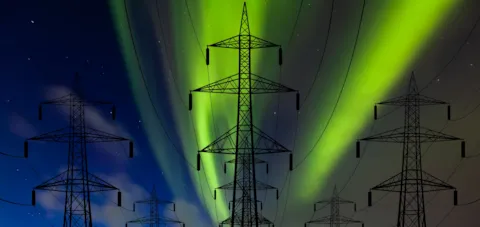The energy transition is still at the starting blocks
Global energy-related emissions are still climbing and are only likely to peak in 2024. This was not the plan.
But the transition is affordable, with energy expenditure reducing from 3% of GDP today to 2% by 2050. Additionally, it offers economic opportunities for all nations.
War rages in the Middle East
With just weeks left to the start of COP28 in Dubai, global geopolitical events again overtake us, as they did with COVID in early 2020, and in February 2022 with the invasion of Ukraine. An escalation of conflict beyond the currently affected zones in the Middle East could threaten the already concerning state of energy access around the world. We also witnessed direct sabotage of the Finland to Estonia gas pipelines and have seen cyber activity that seeks to further damage energy assets around the world These events create uncertainty and could lead to national level decisions that may not help drive the transition in the most effective and speedy manner.
Global stocktake..... actions speak louder than words
This year marks the first Global Stock Take (GST), a review of where countries are on their net zero ambitions. It is not going to be happy reading, with the likelihood that very few, if any, countries are on the pathway to net zero by 2050 or earlier. At the Glasgow Climate Pact in November 2021, countries agreed to submit strengthened NDCs in 2022. Seventy have submitted their NDCs since then, mostly “updated” or “enhanced” versions (including the 27 member states of the EU). According to the IEA, “...the momentum behind clean energy technologies means that the existing near-term climate goals set out by countries in their Nationally Determined Contributions (NDCs) are almost within reach at a global level. However, the ambition of these NDCs globally is not aligned with the goals of the Paris Agreement yet.” That said, we are seeing positive policy actions that could see regions like the EU and the USA to get close to net zero by 2050.
COP28 Presidency priorities
The COP28 Presidency under Dr Sultan Al Jaber have identified the following as key areas of focus:- Fast-track the energy transition and slash emissions before 2030
- X3 renewable energy and doubling the rate of energy efficiency improvements by 2030 through electrification and phase-down of fossil fuels.
- Halving oil and gas industry scope 1 and 2 emissions, including reaching near-zero methane emissions by 2030.
- Accelerate efforts towards the phasedown of unabated coal power and phase-out of inefficient fossil fuel subsidies.
- Transform climate finance
- Support developing countries to obtain $2.4 trillion of annual investment in climate action by 2030.
- Replenish the Green Climate Fund (GCF).
- Put nature, people, lives, and livelihoods at the heart of climate action
- Provide adaptation finance.
- Operationalize funding arrangements for loss and damage.
- Mobilize an inclusive COP
- Ensure engagement from all stakeholders, including youth, local communities, faith groups, women, and indigenous peoples.
Bold and decisive actions can get us there
The COP28 Presidency will facilitate negotiations on the above climate issues, but on mitigation, we the opportunity to take no regret moves in several areas:
1. Implementation – deploy, deploy deploy!
- Action now is urgent. Let’s share case studies and create standards so others can act quickly and at lower cost.
2. Big Bets – channel investment to the things we know.
- Electrification is a given and we need scale-up of renewables, new grid investments along with flexibility and storage.
- Gas is going to be around; let’s decarbonize and invest in carbon capture, utilities and storage (CCUS).
3. Emerging threat of energy infrastructure security.
- Physical and cyber threats to our critical energy assets have already happened. Let’s ensure we protect these to deliver a safe, reliable, resilient, and secure energy system.
Alongside each, regulation must go hand in hand. So,
- To implement, we need to ease the process of deployment (permitting, auction design, incentives, penalties, etc.)
- Give the market clear signals to create supply and demand in equal measure.
- National/regional government and asset owners must work collaboratively to better understand the threats and deploy risk management approaches to protect infrastructure.
DNV priorities for COP28
DNV has set itself the goals to support the energy sector around two high-level priorities:
- Scaling renewables: Triple renewables capacity by 2030, supported by grid expansion and energy storage.
- Decarbonizing oil and gas: Support the industry to reduce emissions through use of CCUS, electrification and elimination of upstream methane emissions.
We look forward to a fruitful, collaborative, inclusive and safe COP in Dubai.
10/31/2023 9:00:00 AM
